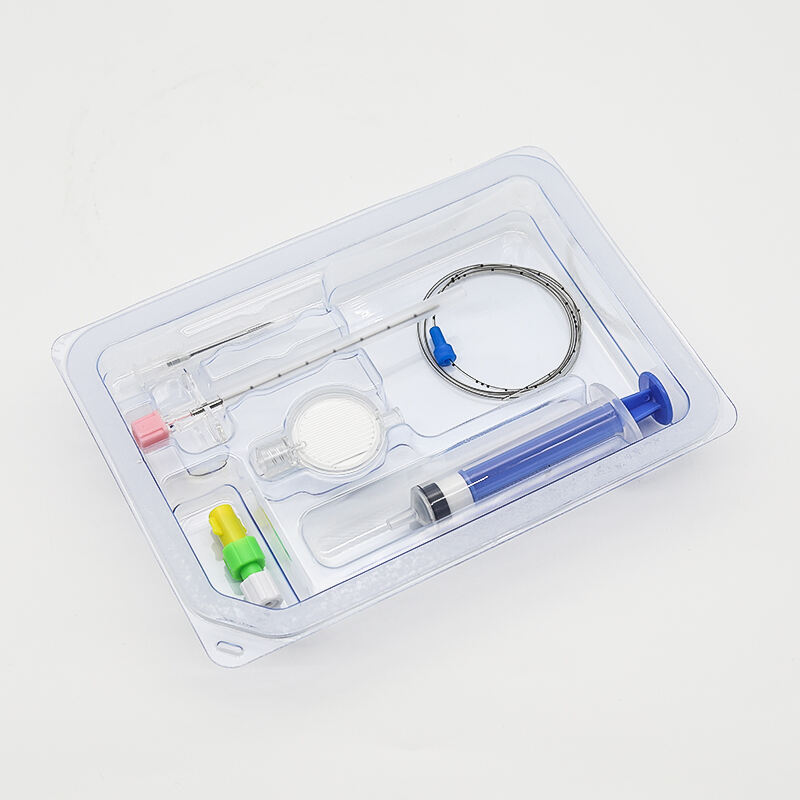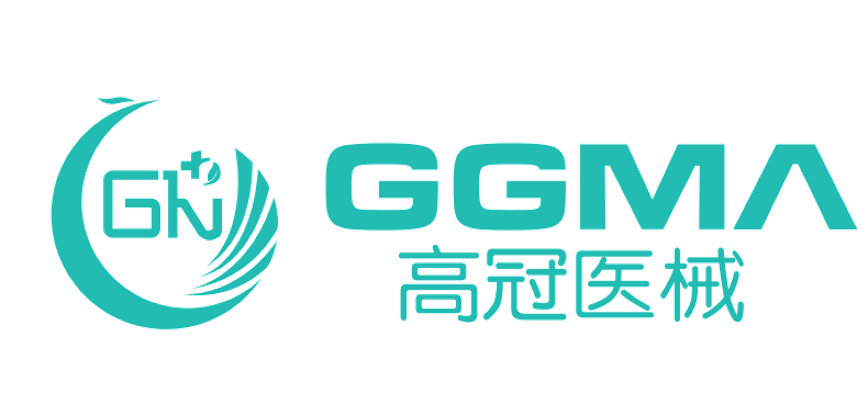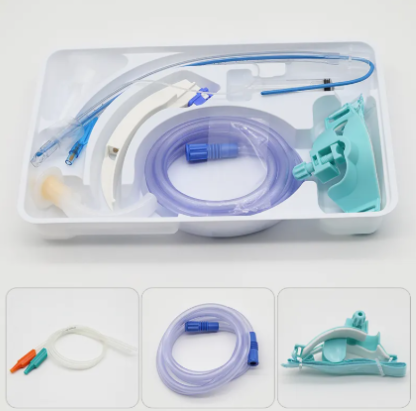المكونات الأساسية لمجموعة التخدير
أدوات إدارة المسار الهوائي لضمان التهوية الآمنة
إن إدارة الطرق التنفسية بشكل صحيح أمر بالغ الأهمية لضمان تنفس المرضى بأمان أثناء العمل التخديري. توجد عدة أدوات مختلفة لهذا الغرض، من أنابيب القصبة الهوائية إلى أقنعة الحنجرة والطرق التنفسية الفموية، وكل منها مصمم لحالات معينة. توضع أنابيب القصبة الهوائية عبر الحبال الصوتية مباشرة، مما يساعد على منع الانسداد أثناء الجراحة. يفضل العديد من الأطباء أقنعة الحنجرة لأنها توضع بسرعة فوق منطقة الصوت. كما تسهم الطرق التنفسية الفموية أيضًا في الحفاظ على وضوح المجاري الهوائية، وخصوصًا منع اللسان من حجب تدفق الهواء. اختيار المقاس والنوع الصحيحين أمر بالغ الأهمية، خاصة لأن الأطفال يحتاجون إلى معدات مختلفة تمامًا عن تلك الخاصة بالبالغين. إن اتخاذ قرارات صائبة في هذا السياق لا يتعلق فقط باتباع البروتوكول، بل يحدد حرفيًا ما إذا كان المريض سيتلقى كمية كافية من الأكسجين أثناء العملية. سيؤكد لك معظم أطباء التخدير ذوي الخبرة أن هذا القرار يمكن أن يكون الفارق بين إجراء سلس ومضاعفات محتملة قد تظهر لاحقًا.
أنظمة تسليم الأدوية ومدى توافق العقاقير
صناديق التخدير تأتي مجهزة بطرق مختلفة لتسليم الأدوية، بما في ذلك الحقن، والمضخات التبديلية، وأجهزة الاستنشاق التي تساعد في إيصال الأدوية إلى المكان المطلوب. تسمح الحقن للأطباء بقياس الجرعات بدقة، وهي نقطة مهمة جدًا عند التعامل مع أدوية قوية. تحافظ المضخات على تدفق مستمر خلال العمليات الطويلة، مما يساعد على الحفاظ على تركيز مناسب للدواء بمرور الوقت. ثم تأتي خيارات أجهزة الاستنشاق الخاصة بالمخدرات الغازية، التي تتيح للمريض استنشاقها بسرعة. لكن الأمر لا يتعلق فقط بإدخال الأدوات الصحيحة إلى العلبة. فمدى توافق الأدوية مع بعضها البعض مهمٌّ جدًا أيضًا. يمكن أن يؤدي خلط بعض الأدوية معًا إلى حدوث مشكلات، وشهدنا العديد من الحالات التي أدت فيها التوليفات غير المتوافقة إلى مشكلات خطيرة أثناء العمليات. ولهذا السبب تقضي المستشفيات الكثير من الوقت في التحقق من الأدوية التي تتوافق مع بعضها قبل وضع أي شيء داخل هذه العلب.
أجهزة المراقبة لتقييم المريض في الوقت الفعلي
لا تكتمل مجموعات التخدير دون أجهزة مراقبة تجمع البيانات عن المرضى أثناء تخديرهم. أجهزة قياس نبضات الأكسجين، تلك الأجهزة الصغيرة التي تُثبت على الأصابع، وأجهزة قياس نسبة ثاني أكسيد الكربون في الزفير التي تفحص مستويات CO2، وأجهزة مراقبة القلب التي تتحقق من نشاط القلب، جميعها تلعب دورًا مهمًا. يُظهر قياس نبضات الأكسجين كمية الأكسجين التي تصل إلى الأنسجة، ويعكس قياس نسبة ثاني أكسيد الكربون في الزفير ما يحدث لثاني أكسيد الكربون في النفس الزفير، بينما يُظهر تخطيط القلب نبض القلب بشكل يتيح لنا مراقبته طوال العمليات الجراحية. إن توفر هذه السلسلة المستمرة من المعلومات يُحدث فرقًا كبيرًا عند اتخاذ القرارات بسرعة أثناء العمليات. ويعتمد سلامة المريض على ذلك حقًا، ليس فقط أثناء العملية نفسها بل أيضًا أثناء التعافي بعدها. سيؤكد معظم أطباء التخدير ذوي الخبرة أن القياسات الدقيقة من هذه الأجهزة تعني الفرق بين اكتشاف المشاكل مبكرًا أو تفويتها تمامًا عندما تتغير الحالة فجأة.
ميزات السلامة في مجموعات التخدير الحديثة
آليات الأمان الاحتياطي لمنع الجرعة الزائدة
تأتي أدوات التخدير الحديثة مزودة بعديد من ميزات الأمان المصممة لإيقاف الجرعات الزائدة قبل حدوثها. إن أحد الأجزاء الرئيسية في ذلك هو آلة حاسبة الأدوية الآلية المدمجة في العديد من الأنظمة الحديثة. تعمل هذه الأدوات المفيدة على حساب كمية المخدر المطلوبة بدقة لكل مريض بناءً على عوامل مثل وزن الجسم والعمر. تحليل الأرقام المستقاة من سجلات المستشفيات خلال السنوات القليلة الماضية يُظهر أمرًا مثيرًا للاهتمام، وهو أن هذه الآلات الحاسبة تقلل فعليًا من الجرعات الزائدة العرضية بشكل ملحوظ. وهذا يُحدث فرقًا حقيقيًا في غرف العمليات في كل مكان. يقدّر الأطباء المتخصصون في التخدير امتلاكهم لهذه الأدوات لأنها تعطيهم شعورًا أكبر بالثقة تجاه ما يقومون به، مما يعني أن المرضى يحصلون على رعاية أفضل في مختلف المواقف الطبية.
تصميم اقتصادي لاستجابة فعالة في حالات الطوارئ
تُعدّ أدوات التخدير التي تم تصميمها مع مراعاة عوامل الراحة أمرًا بالغ الأهمية عند الاستجابة للحالات الطارئة. كيف تُرتّب هذه الأدوات الحديثة تسمح للطاقم الطبي بالوصول السريع إلى الأجزاء الضرورية فورًا، بما في ذلك أدوات المسالك الهوائية وأنظمة توصيل الأدوية التي تصبح ضرورية تمامًا في لحظات الأزمات. وبحسب دراسات نُشرت في السنوات الأخيرة، فإن التصميم الجيد من حيث الراحة يساعد فعليًا في تقليل الأخطاء التي تحدث تحت الضغط لأن كل شيء منظم بطريقة منطقية وفي متناول اليد. لقد شهدنا هذا الأمر بشكل مباشر في غرف العمليات حيث يمكن للممرضات أن يلتقطوا ما يحتاجون إليه دون أي تردد، وهو ما يوفّر ثوانٍ ثمينة وربما أرواحًا. عندما يبدأ المصنعون في التفكير في كيفية تكيّف معداتهم مع الظروف الواقعية، وليس فقط في البيئات المخبرية، فإن ذلك يُظهر اهتمامًا حقيقيًا لكل من العاملين في الرعاية الصحية والمرضى على حد سواء.
معايير الامتثال والشهادات
إرشادات FDA لمعدات التخدير
من المهم بمكان التعرف على قواعد إدارة الغذاء والدواء (FDA) المتعلقة بمعدات التخدير من أجل ضمان سلامة المرضى ونجاح الإجراءات الطبية. تشدد الإرشادات بشكل كبير على ضرورة إجراء اختبارات شاملة وفحوصات صارمة للجودة قبل طرح أي جهاز في السوق. ويجب على الشركات المصنعة لهذه المعدات اتباع خطوات محددة تشمل تقديم الأوراق المطلوبة قبل بيع منتجاتها ومتابعة مراقبتها بعد توفرها. في الواقع، تلتزم معظم الشركات بهذه اللوائح بشكل جيد، مما يسهم في تحسين الظروف في المستشفيات والعيادات. ولا يتعلق الالتزام بمعايير إدارة الغذاء والدواء فقط بالامتثال، بل يساهم أيضًا في بناء الثقة. فعندما يرى الأطباء أن الشركة المصنعة تلتزم بهذه الشروط الصارمة، فإنهم يثقون أكثر في هذه الأجهزة، إذ يعلمون أنها مرت بإجراءات تقييم مناسبة.

شهادة ISO 13485 لأمان الأجهزة الطبية
إن الحصول على شهادة ISO 13485 تُعدّ أمراً بالغ الأهمية بالنسبة للشركات التي تُنتج أدوات التخدير، لأنها تُظهر التزامها بالجودة وإدارتها المُنضبطة للمخاطر على طول عملياتها. عندما يمتلك المُصنّع هذه الشهادة، فهذا يعني أن أنظمة ضمان الجودة لديه تتوافق مع معايير دولية صارمة خاصة بالمعدات الطبية، مما يجعل المنتجات أكثر أماناً بشكل عام. تشير الدراسات إلى أن امتلاك الشركات لشهادة ISO 13485 يمنحها ميزة في السوق، حيث يعرف العملاء أن هذه الشركات تتبع بروتوكولات صارمة للسلامة. وبالنسبة للمُصنّعين الذين يعملون بشكل خاص على أدوات التخدير، فإن الحفاظ على جودة مُتميزة عبر الدفعات المختلفة يصبح أسهل بكثير عندما تكون الشهادة متوفرة. وهذا يؤدي مباشرةً إلى نتائج أفضل أثناء العمليات الجراحية، ويُعزز ثقة أكبر لدى مهنيي الرعاية الصحية الذين يعتمدون يومياً على هذه الأدوات الحيوية.
الابتكارات في تقنية مجموعة التخدير
تكامل الرصد الذكي لتحقيق رعاية دقيقة
لقد أدى إضافة تقنيات المراقبة الذكية إلى معدات التخدير إلى تغيير كبير في مدى دقة وكفاءة الرعاية الطبية. مع هذه الأدوات الجديدة، يحصل الأطباء على جميع بياناتهم متزامنة تلقائيًا وتحليلها في الوقت الفعلي، مما يمّكنهم من اتخاذ قرارات أفضل أثناء إجراء العمليات الجراحية. كما تعتمد العديد من هذه الأنظمة الذكية أيضًا على الذكاء الاصطناعي في الخلفية. يساعد هذا الذكاء الاصطناعي الأطباء في إجراء التعديلات فورًا وفقًا لحالة كل مريض الفريدة. على سبيل المثال، إذا انخفض ضغط دم المريض بشكل مفاجئ أثناء العملية، فقد يُخطِر النظام أخصائي التخدير قبل أن تصبح الحالة حرجة. يؤدي إدارة التخدير بشكل أفضل إلى تحسين نتائج المرضى بشكل مباشر. ما نراه هنا ليس مجرد جهاز متطور، بل هو تقدم حقيقي في الطب يجعل العمليات الجراحية أكثر أمانًا ويقلل من المخاطر لكل من يشارك فيها.
أنظمة تسليم غاز التخدير الصديقة للبيئة
تبدأ المنشآت الطبية في جميع أنحاء البلاد في اعتماد أنظمة غازات التخدير الصديقة للبيئة كجزء من جهودها لتقليل الأضرار البيئية الناتجة عن العمليات الروتينية. تعمل هذه الأنظمة الحديثة بشكل مختلف مقارنة بالأنظمة التقليدية، حيث تطلق كميات أقل بكثير من الغازات الضارة وتستخدم مواد يمكن إعادة تدويرها أو التخلص منها بطريقة آمنة. وبحسب تحليلات السوق الأخيرة، فإن المستشفيات تتجه بشكل متزايد نحو الخيارات الأكثر صداقة للبيئة في مجال التخدير خلال السنوات القليلة الماضية. وجزء من هذا الاتجاه يعود إلى زيادة الوعي لدى الأطباء والموظفين حول ما يحدث للمواد الناتجة عن العمليات الجراحية بعد الانتهاء منها، إضافة إلى الضغوط التي تمارسها الهيئات التنظيمية على مزوّدي الرعاية الصحية ليلتزموا بمعايير استدامة معينة. كما أن الاتجاه نحو الحلول الصديقة للبيئة لا يفيد الكوكب فحسب، بل يُعد منطقيًا من الناحية التشغيلية أيضًا، نظرًا لأن هذه الأنظمة تكون عادةً أكثر أمانًا للمرضى وتحتاج إلى صيانة أقل بشكل عام. نحن نشهد استمرار هذا التحرك وازدياد زخمه مع تطوير الشركات المصنعة حلولًا أفضل لا تؤثر سلبًا على النتائج السريرية مع الحفاظ في الوقت نفسه على البيئة.
الأسئلة الشائعة
ما هي فوائد استخدام تقنية المراقبة الذكية في مجموعات التخدير؟
تكنولوجيا المراقبة الذكية تُحسّن تحليل البيانات والتناسق، مما يزيد من الدقة في الرعاية ويسهّل التعديلات الفورية بناءً على احتياجات المريض.
كيف تمنع آليات الأمان الاحتياطي الجرعات الزائدة في مجموعات التخدير؟
تُضمن آليات الأمان الاحتياطي مثل حاسبات جرعات الأدوية الآلية إدارة دقيقة بناءً على بيانات خاصة بالمريض، مما يقلل بشكل كبير من خطر الجرعات الزائدة.
لماذا تعتبر شهادة ISO 13485 مهمة لمصنعي مجموعات التخدير؟
تشير شهادة ISO 13485 إلى الالتزام بمعايير السلامة العالية والتحسين المستمر، مما يساهم في سلامة المنتج وتنافسية السوق.
كيف تفيد أنظمة تسليم الغازات المخدرة الصديقة للبيئة البيئة؟
تقلل الأنظمة الصديقة للبيئة من انبعاثات الغازات الدفيئة وتستخدم مواد وعمليات مستدامة، مما يشجع على حماية البيئة في الممارسات الطبية.

